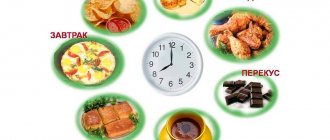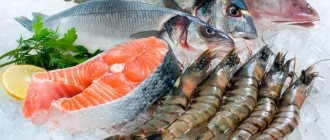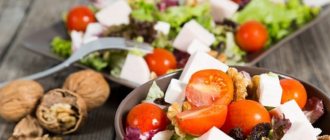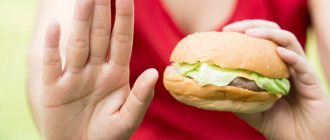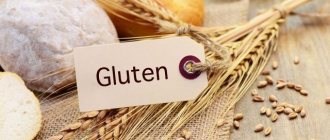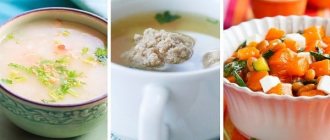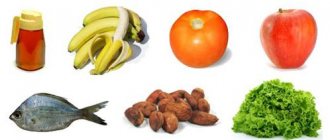General characteristics of dietary table No. 5P (II)
Diet No. 5P (II) is characterized by a high protein content with a moderate limitation of easily digestible carbohydrates and salt. The diet is moderately gentle and involves limiting extractives and coarse fiber. Food is steamed, boiled, baked, stewed. It is advisable to chop all food and wipe it if necessary. Diet No. 5P (II) provides for fractional meals 5-6 times a day in strictly small portions. The diet is prescribed for 2–3 months after diet No. 5P (I). If the patient's condition worsens on diet No. 5P (II), it is necessary to return to the previous table.
What foods are allowed and not allowed on diet No. 5?
Important information! You should not consider such nutrition as an alternative to treating the disease, because it is not able to get rid of the disease. The diet is designed to alleviate and minimize the consequences of the disease, and maintain optimal well-being during the rehabilitation period.
It is strictly forbidden to eat fried foods, foods containing refractory fats and high cholesterol content.
You should definitely monitor the calorie content a table with exact numbers calculated per 100 grams will help with this finished product.
It is advisable to cook food using a double boiler or slow cooker (only lightly grease the bowls) so that the food does not stick to the surface. All coarse fibers - meat and tough vegetables - must be crushed and rubbed through a sieve.
It is recommended to cook the first courses in water or vegetable broth, or in a second, and best of all, a third meat broth. In addition to vegetables, you can add a little cereal or pasta to soups to make them more filling.
The diet should be based on vegetables and fruits , which are rich in fiber and pectin, as well as foods containing lipotropic components.
Particular attention should be paid to the temperature - the food should be warm, not cold. It is recommended to heat it to a temperature of about 40-45 degrees, that is, slightly above body temperature.
You need to eat fractionally, at regular intervals ranging from 2 to 4 hours, then the load on the digestive organs will be small, and light food will be well absorbed.
Chemical composition and energy value of dietary table No. 5P (II)
Proteins: 110–120 g (including up to 50 g of animal proteins). Fats: 80–90 g (including 1/3 of the amount - vegetable fats). Carbohydrates: 250–350 g (including up to 40 g of simple carbohydrates). Daily calorie content: 2,100 – 2,700 kcal. Free liquid: 1.5–2 l. Table salt: 6–8 g. Vitamins: retinol (A) – 0.4 mg, beta-carotene – 13 mg, riboflavin (B2) – 2.6 mg, thiamine (B1) – 1.3 mg, nicotinic acid ( B3) – 17 mg, ascorbic acid (C) – 250 mg. Macroelements: sodium – 4 g, calcium – 1.3 g, magnesium – 0.5 g, phosphorus – 1.9 g. Microelements: iron – 35 mg. Optimal food temperature: from 15 to 60 degrees Celsius.
Diet menu options No. 5, for a week, 7 days
The photo below shows an example of the complex composition of diet table number 5, for 7 days of the week, with breakfasts, lunches and dinners. The composition includes classic dishes, with the cooking rules described above.
The photo table shows the diet menu table No. 5 for seven days. (Photo clickable)
A couple more options for the diet menu table No. 5, according to Pevzner, an approximate menu in the table for the week, from Monday to Sunday. Scheduled for breakfast, lunch, afternoon tea and dinner:
The photo shows an approximate diet menu, table No. 5, for 7 days of the week. (Photo clickable)
And the third example:
The photo table shows the weekly diet menu No. 5, according to Pevzner, divided into 1st breakfast, 2nd breakfast, lunch, afternoon snack, dinner, meal before bed and the amount of bread for the whole day. Menu with examples of dishes from Monday to Sunday. (Photo clickable)
And finally, an example of a diet menu from the book:
Example of diet menu No. 5, photo of the table from the book. (Photo clickable)
Especially for medical information site
Recommended products and dishes of the dietary table No. 5P (II)
Bread: wheat crackers, yesterday's and dried wheat bread. Soups: slimy cereal soups with vegetable broth or water, vegetable soups with chopped boiled vegetables, pureed meat and potato soups. Meat dishes: lean meats and poultry without skin in the form of boiled or steamed cutlets, soufflés, quenelles, etc.; chopped cutlets, beef stroganoff, tongue are allowed; soy protein is recommended. Fish dishes: boiled or steamed low-fat fish in pieces, chopped, in the form of cutlets, soufflé. Side dishes: pureed vegetable purees, soufflés, pureed semi-viscous porridges, puddings and casseroles made from rice, oatmeal, buckwheat, pearl barley and semolina; Boiled pasta is allowed. Dairy products: fresh unleavened cottage cheese and steam soufflé made from it, non-acidic dairy products, low-fat milk, mild cheeses. Eggs: steamed egg white omelet. Snacks: excluded. Sauces: milk, berry. Sweet dishes: jelly, fruit mousses, baked apples, marshmallows, marshmallows, fresh bananas and strawberries if tolerated; sugar is limited, it is recommended to use substitutes. Drinks: weak tea, compotes, rosehip decoction, diluted sweet berry juices. Fats: fresh unsalted butter in small quantities in dishes on the 3rd day, refined vegetable oils - on the 5th day.
Diet 5 table according to Pevzner: menu for the week and recipes
With diet table number 5, the menu for the week for each day can be varied, since the products that are allowed for consumption are enough to allow you to prepare different recipes. Below you can familiarize yourself with the menu, or download it to your computer in .doc format.
| Monday | |
| Breakfast |
|
| Lunch |
|
| Dinner |
|
| Afternoon snack |
|
| Dinner |
|
| For the night |
|
| Tuesday | |
| Breakfast |
|
| Lunch |
|
| Dinner |
|
| Afternoon snack |
|
| Dinner |
|
| For the night |
|
| Wednesday | |
| Breakfast |
|
| Lunch |
|
| Dinner |
|
| Afternoon snack |
|
| Dinner |
|
| For the night |
|
| Thursday | |
| Breakfast |
|
| Lunch |
|
| Dinner |
|
| Afternoon snack |
|
| Dinner |
|
| For the night |
|
| Friday | |
| Breakfast |
|
| Lunch |
|
| Dinner |
|
| Afternoon snack |
|
| Dinner |
|
| For the night |
|
| Saturday | |
| Breakfast |
|
| Lunch |
|
| Dinner |
|
| Afternoon snack |
|
| Dinner |
|
| For the night |
|
| Sunday | |
| Breakfast |
|
| Lunch |
|
| Dinner |
|
| Afternoon snack |
|
| Dinner |
|
| For the night |
|
Diet 5 table according to Pevzner: recipes for cooking
Considering that much is prohibited, we offer you recipes for the fifth table so that you can prepare delicious and satisfying food. You need to remember that you need to eat food 5 times a day.
- For breakfast they usually eat milk porridge or pudding. Even the laziest person can cook milk porridge. But for the pudding you need a recipe.
Curd pudding
- Low-fat cottage cheese - 500 gr.
- Eggs - 2 pcs.
- Milk - 12 cups.
- Semolina - 3 spoons.
- Melted butter, vanillin, raisins, sugar.
First, pour semolina with milk and wait until it swells. The cottage cheese must be thoroughly blended in a blender. It should become soft.
Also use a blender to beat the butter and eggs. Vanillin and sugar are also added there. Then combine everything together and mix. Pour into molds and bake for 20 minutes. The oven or multicooker temperature should be 200 degrees. And the delicious pudding is ready! Read the special diet 7 menu in the next article.
- For second breakfast, you can eat a baked apple or any fresh fruit.
- For lunch, eat low-fat soup. You can cook porridge with vegetables, bake chicken. Compote is required. For afternoon tea, a decoction of herbs.
Diet menu number 6 for gout may also be relevant for you.
Vegetable soup recipe for diet table 5
- Zucchini - 60 gr.
- Potatoes - 40 gr.
- Tomato or carrot - 20 gr.
- Onions and parsley - 10 gr.
- Butter.
- Vegetable broth - 500 gr.
- Sour cream (10% fat) - 10 ml.
Finely chop all vegetables (except potatoes) and simmer a little in water with butter. Add diced potatoes to the mixture and cook for another 20 minutes. Pour the vegetable mixture into the broth and cook until the potatoes are ready. Serve with sour cream and herbs (finely chopped).
- If you had meat for lunch, then you should cook fish for dinner. Vegetable puree goes well with it. You can eat cheesecake with compote.
- Low-fat kefir is allowed before bed.
If you stick to this diet for a long time, you need to improvise and cook different dishes. Variety will help you stay on a diet with ease and not break down.
Excluded foods and dishes of the dietary table No. 5P (II)
From the diet you should exclude fried meat, fish, mushroom broths, saturated vegetable broths, any raw vegetables, fresh fruits, cabbage, turnips, radishes, rutabaga, onions, garlic, leaf salads, sorrel, spinach, radishes, mushrooms, legumes, fatty varieties of meat, poultry and fish, liver, brains, pickles, smoked meats, sausages, canned food, caviar, lard, cooking fats, eggs (except for white omelettes), fresh bread, butter dough, flour products, cream, full-fat milk, mayonnaise, confectionery products, chocolate, cocoa, ice cream, alcoholic drinks, carbonated drinks, hot seasonings, spices and sauces, including tomato.
Prohibited Products
Any dishes and food products that have a large amount of fat are completely prohibited. There are actually quite a lot of them. This is not only pork or lard, but also ice cream, margarine and others.
You should not eat fruits that have hard, even small, seeds. These include currants and raspberries. Rough peel will also negatively affect the functioning of the stomach. Therefore, gooseberries, dates, and figs are prohibited.
Under no circumstances should you eat legumes or dishes containing them.
Naturally, the amount of salty, pickled dishes should be reduced to zero. That is, nothing that irritates the digestive tract.
Sample diet menu No. 5P (II)
First breakfast: steamed curd pudding, milk porridge, tea. Second breakfast: boiled tongue, crackers, tea. Lunch: slimy soup with rice and vegetable broth, beef stroganoff, vegetable puree, compote. Afternoon snack: fish soufflé, jelly. Dinner: chicken quenelles, cottage cheese, rosehip broth. At night: kefir.
Sources:
- Order of the Ministry of Health of the Russian Federation No. 330 “On measures to improve clinical nutrition in medical institutions of the Russian Federation” dated 05.08.2003
Pevzner diet
Therapeutic diet 5 table, strictly limiting what can and cannot be included in the patient’s diet, allows you to reduce the load on problem organs without losing the quality of nutrition. In addition to a more gentle thermal and mechanical effect on the gastrointestinal tract, a therapeutic diet helps normalize lipid metabolism, improves the functionality of the bile ducts and helps cleanse the liver.
The opinion of gastroenterologists on the Pevzner diet is unanimous - without therapeutic nutrition it will not be possible to achieve stable remission. Reasons for appointment:
- chronic inflammation of the liver;
- cirrhosis (excluding failure of function);
- cholecystitis;
- pancreatitis;
- duodenitis;
- pathologies of the gallbladder and biliary tract.
The therapeutic effect is based on compliance with certain principles (more on this below), it helps reduce:
- chemical load on organs (extractive elements that provoke organ activity are excluded);
- mechanical load - due to the quality of food preparation, composition and mode of consumption;
- irritation of the mucous membrane - it is recommended to adhere to the food temperature in the range from 20 to 60°C, which is physiological for the body.
Due to fractional meals (you need to eat every 3 hours) and easily digestible dishes, the human body processes it without stress.
All the details are in the video about the diet:
Diet No. 5: recipes
• Beet and prune salad.
200 g of beets are boiled, peeled and cut into bars or grated on a coarse grater. A couple of hours before preparing the salad, soak 70 g of prunes in boiling water, then drain the water and finely chop it into pieces. Add a little salt and 40 g of low-fat sour cream.
• Rice and apple porridge.
2 medium apples are cut into small pieces, after cutting out the core, and placed in boiling water diluted in half with milk (1 glass of water + 1 glass of milk). After 5 minutes, add half a glass of rice and cook until tender. 5 minutes before the end of cooking, add 1 tablespoon of sugar and a little butter.
• Fruit salad.
To prepare the salad, you will need to peel and prepare 40 g of apples, 30 g each of tangerines, bananas and strawberries. Cut the fruit into pieces, sprinkle with sugar and add 30 g of low-fat sour cream.
• Carrot and banana salad.
Large carrots are peeled and grated on a coarse grater. The pulp of one banana is cut into pieces. Mix the ingredients, sprinkle with sugar and pour in 100 g of sour cream or homemade yogurt.
• Corn porridge with prunes.
50g of prunes are boiled in 200 ml of water and left for 30 minutes to swell. The prunes are taken out and 80 g of corn grits are added to the broth, where they are cooked until tender over very low heat. At the end of cooking, add a little salt and 10 g of butter.
• Milk-rice soup.
Boil 5 tablespoons of rice in 500 ml of boiling milk. When the soup is ready, remove it from the heat, cool, add a piece of butter and honey.
• Strawberry milk soup.
Add 1 cup of oatmeal to 1 liter of boiling milk. Bring to a boil, add 150 g of washed strawberries, 1 tablespoon of sugar and a little salt. Bring the soup to a boil, turn off and leave for 20 minutes. Can be consumed both cold and hot.
Tags: weight loss
Market Analytics
- Black Lives Matter movement: reaction and consequences for the beauty industry
- COVID-19 is changing the rules of the game in the cosmetics market
- Beauty of the future: cosmetic innovations 2020
Convenient search for beauty salons on our website
Beauty salons in Moscow Beauty salons in St. Petersburg Beauty salons in Ekaterinburg Beauty salons in Novosibirsk
Latest blog posts on our website
- Naturecream / SPF in Natural Oils
- Naturecream / Geranium (Pelargonium) oil for skin health and beauty
- Prostye-sovety / Save on a beauty salon: procedures that can be done at home
- Naturecream / Growth Factor - brings back youth?
- Oksana-Lezina / 3 effective abdominal exercises from a fitness instructor for beginners
- Prostye-sovety / Making perfect curls at home
- Prostye-sovety / Which hair removal method to choose
- Naturecream / Wrinkles Puppets
- Naturecream / PEPHA-TIGHT - instant skin lifting
- Naturecream / Blue light - a danger to the skin
Latest forum topics on our website
- Mrs._Smith / Badly sunburned! What to do?((
- Ice / Is it necessary to combine fitness classes with a diet?
- Antonova / What can be used for hair loss?
- Radio operatorKat / Who was on a protein diet?
- Suzanna / Mesotherapy on the face
Other articles in this section
| Chronodiet. Nutrition by the hour Disputes around the topic of proper nutrition arise constantly. A modern person does not need to be convinced that high-quality and varied foods are needed to ensure that the body receives the necessary fats, proteins, carbohydrates, as well as microelements and vitamins. The higher the status of people, the more carefully they plan their lifestyle: limiting the consumption of unnecessary calories, playing sports, leading an active lifestyle and finding different hobbies. |
| Diet “Favorite” Recipes for effective weight loss are necessarily present in every woman’s arsenal. The “Favorite” weight loss diet is one of the ways to quickly return weight to normal and cleanse the body. What are the food options? How do doctors feel about diet? What results can be achieved if you use different methods of losing weight? Let's try to figure it out in the article. |
| Blood type diet The blood type diet gained popularity at the end of the last century. At that time, there was a real boom in various nutrition systems and each author sought to find the most interesting explanation for the diet he had invented. It is not surprising that the concept, based on the use of necessary and unnecessary foods according to blood type, immediately attracted attention. |
| Low-carbohydrate diet A low-carbohydrate diet is a nutritional system in which the amount of simple carbohydrates (sweets, flour products, sugar) is limited to a minimum. In this case, it is necessary to eat foods containing complex carbohydrates, as well as proteins and fats. |
| The Angel Diet The Angel Diet is a short-term low-carbohydrate diet that helps you quickly get rid of extra pounds. Excluding carbohydrates from the diet contributes to the fact that the body begins to use up its own fat reserves, and therefore loses volume and weight. The diet got its name due to its widespread popularity among models. |
| The Dukan Diet The effective nutrition system created by Pierre Dukan, which allows you to lose a few kilograms without much hardship, is steadily finding new adherents. There is nothing surprising. In addition to weight loss, the diet stabilizes weight for a long time, as millions have already seen, so the effectiveness of the Dukan system has been tested and confirmed many times. |
| The Kremlin diet It is difficult to imagine a food system where unlimited consumption of meat and fish products, eggs, and all kinds of delicacies is encouraged. Moreover, strong alcoholic drinks are allowed. The Kremlin diet for weight loss is just what lovers of tasty and satisfying food need; it is no coincidence that many politicians, cultural figures and show business stars have tried this nutritional option. |
| BEACH (protein-carbohydrate alternation) diet The protein-carbohydrate alternation diet is a nutrition system that allows you to effectively lose weight. Initially, this weight loss option was developed specifically for athletes who, with its help, achieved special body contours. The idea of the diet belongs to American nutritionist Jason Hunter. |
| Home diet A home diet for weight loss is one of the simplest and most accessible ways to lose weight, since it does not require exotic, rare foods, and there is no need to count calories. You need to eat simple, homemade dishes prepared from ordinary products. |
| Diet for the lazy In the fight against excess weight, many women try to find the easiest and most effective way to lose weight, which will not harm their health and will allow them to get rid of unnecessary pounds. The water diet for the lazy is one of the options that allows you to quickly return to your ideal weight. But as with any diet, there are advantages, disadvantages and features. Let's talk about them in more detail. |
Therapeutic diet No. 5 for children
Doctors often prescribe a diet in accordance with table No. 5 for children with viral hepatitis and chronic pancreatitis. However, this method of nutrition helps improve the functioning of the digestive organs and can be used to provide adequate nutrition to completely healthy children.
The menu includes all the necessary products, such as meat, fish, milk, cottage cheese, fruits and vegetables. The child receives all the necessary nutrients, microelements and vitamins. The method of processing food (cooking, steaming, stewing) allows you to save everything that is most valuable. Gentle nutrition helps prevent the development of digestive diseases, which affect many modern children.


